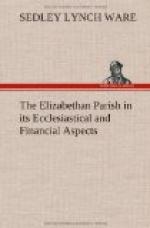At St. Dunstan’s, Stepney parish, London, a book was made by the wardens “whearein was expressed the pewes in the whole Church,” distinguished by numbers. “Also there was noted against everie pewe the price that was thought reasonable it shoulde yeeld by the yeare.... The w[hi]ch rates by this vestrie is allowed and confirmed to be imploied to the use of the parish Church.” When a few months later it was determined to build a gallery because the congregation needed more seats, it was also settled that the cost should be met by a year’s pew rent in one payment down, over and besides the usual quarterly payments for seats.[287] Sometimes the seats were sold outright and for life only.[288]
Mortuary Fees were a source of revenue in almost all parishes, and sometimes an important one.[289] Consequently tariffs of fees were drawn up in various places. So much is charged for interment within, so much for burial without the church; so much for a knell according to duration and according to size of the bell; so much for the herse—a sort of catafalque—so much for the pall, the fee varying from that charged for “the best” to that charged for “the worst cloth”; so much if the body is coffined or uncoffined, most of the dead being buried in winding sheets only, though the parish provided a coffin for the body to lie in during service in church and for removal to the graveside.[290] So, too, one fee was charged for interring a " great corse,” another for a “chrisom child."[291] All, in fact, is tabulated with minute precision, the minister getting certain fees for himself alone, and sharing others with the parish; and so of the clerk and of the sexton, if any. Among other reasons alleged by the vestry of Stepney parish for dismissing their sexton in 1601 was because he made “composic[i]on with diu[er]s & sundry p[ar]ishoners for the duties of the church to the hinderannce & great damage of the bennefitt of the church & p[ar]ishoners."[292]
Fees for Weddings, Christenings and Churchings, and for the ringing of the bells (at marriages), together with the Offerings taken up on these occasions, might form a source of revenue to the parish, either going directly into the parish coffers, or being paid in whole or in part to minister, clerk or sexton, who, after all, had to be supported by the parish (or otherwise), being essential officers or servants.[293]
The parish poor and the parish church derived an uncertain, but by no means negligible, income from the product of Fines for various Delinquencies.
In the previous chapter fines for non-attendance at church have been alluded to.[294] A contemporary, writing in 1597, refers to these as an important fund for the support of the poor if duly levied. He writes: “Whereunto [he is speaking of various means to alleviate poverty] if we adde the forfaiture of 12 pence for euerie householders absence from Church (man and woman) forenoone and after, Sunday and holiday (according to the statute without sufficient cause alledged) to be duely collected by Churchwardens and other appointed to that end, with the like regard for Wednesday suppers: there would be sufficient releefe for the poore in all places ...."[295]




